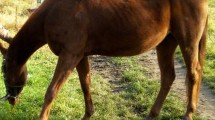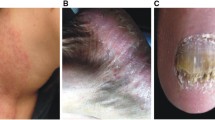Abstract
This article reports the first verified cases of infection by Trichophyton bullosum in Africa since the description of the fungus, isolated in 1933 from the coat of horses in Tunisia and Mali. We found the fungus in cutaneous samples obtained from donkeys suffering from severe dermatitis with areas of alopecia and scaling in the surroundings of Cairo (Egypt). Fungal elements (arthroconidia and hyphae) were seen at the microscopy of material collected by skin scraping and digested in NaOH. Fungal colonies grown on various culture media were identified through PCR and sequencing of the ITS rDNA region. Since the original report in Africa and the Middle East, only a few cases have been reported thus far in humans in France and two cases in horses in the Czech Republic and Japan. Trichophyton bullosum seems thus an infrequent cause of dermatophytosis. However, the actual prevalence of this pathogen may be underestimated due to the similarity with T. verrucosum, a predominant cause of infection in cattle, occasionally found on horses and donkeys. Indeed, the two fungi can be distinguished only via molecular methods, which are poorly employed in epidemiological studies on equine and bovine dermatophytosis. The present study results add to our knowledge on the ecology of this poorly explored dermatophyte, supporting the concept that equines are the primary hosts of T. bullosum and confirming the presence of this pathogen in Africa. At the same time, these are the first unequivocally documented infections in donkeys due to T. bullosum.




Similar content being viewed by others
Availability of data and material
The fungal isolates are publically available in the culture collection CCF (Culture Collection of Fungi, Department of Botany, Charles University, Prague, Czech Republic). The DNA sequences obtained in this study were deposited into the GenBank database (www.ncbi.nlm.nih.gov).
References
Abarca M, Castellá G, Martorell J, Cabañes F (2017) Trichophyton erinacei in pet hedgehogs in Spain: occurrence and revision of its taxonomic status. Med Mycol 55:164–172
Abdalla W, Suliman E, Gabbar A (2005) A report on Trichophyton verrucosum in donkeys in the Sudan. Sudan J Vet Res 20:83–85
Ajello L, Georg LK (1957) In vitro hair cultures for differentiating between atypical isolates of Trichophyton mentagrophytes and Trichophyton rubrum. Mycopathologia 8:3–17
Alzubaidy TSN, Mohammed AJ, Al-Gburi AAH (2018) Comparison of two conventional methods for identification of dermatophyte fungi. Ibn AL-Haitham J Pure Appl Sci 31:21–30
Baert F, Stubbe D, D’hooge E, Packeu A, Hendrickx M (2020) Updating the taxonomy of dermatophytes of the BCCM/IHEM Collection according to the new standard: a phylogenetic approach. Mycopathologia 185:161–168
Cafarchia C, Figueredo LA, Otranto D (2013) Fungal diseases of horses. Vet Microbiol 167:215–234
Chermette R, Ferreiro L, Guillot J (2008) Dermatophytoses in animals. Mycopathologia 166:385–405
Čmoková A, Kolařík M, Dobiáš R, Hoyer LL, Janouškovcová H, Kano R, Kuklová I, Lysková P, Machová L, Maier T, Mallátová N, Man M, Mencl K, Nenoff P, Peano A, Prausová H, Stubbe D, Uhrlaß S, Větrovský T, Wiegand C, Hubka V (2020) Resolving the taxonomy of emerging zoonotic pathogens in the Trichophyton benhamiae complex. Fungal Divers 104:333–387
Čmoková A, Rezaei-Matehkolaei A, Kuklová I, Kolařík M, Shamsizadeh F, Ansari S, Gharaghani M, Miňovská V, Najafzadeh MJ, Nouripour-Sisakht S, Yaguchi T, Zomorodian K, Zarrinfar H, Hubka V (2021) Discovery of new Trichophyton members, T. persicum and T. spiraliforme spp. nov., as a cause of highly inflammatory tinea cases in Iran and Czechia. Microbiol Spectr 9:e00284-e1221
Georg LK, Camp LB (1957) Routine nutritional tests for the identification of dermatophytes. J Bacteriol 74:113–121
Heidemann S, Monod M, Gräser Y (2010) Signature polymorphisms in the internal transcribed spacer region relevant for the differentiation of zoophilic and anthropophilic strains of Trichophyton interdigitale and other species of T. mentagrophytes sensu lato. Brit J Dermatol 162:282–295
Hubka V, Barrs V, Dudová Z, Sklenář F, Kubátová A, Matsuzawa T, Yaguchi T, Horie Y, Nováková A, Frisvad J (2018a) Unravelling species boundaries in the Aspergillus viridinutans complex (section Fumigati): opportunistic human and animal pathogens capable of interspecific hybridization. Persoonia 41:142–174
Hubka V, Nováková A, Jurjević Ž, Sklenář F, Frisvad JC, Houbraken J, Arendrup MC, Jørgensen KM, Siqueira JP, Gené J, Kolařík M (2018b) Polyphasic data support the splitting of Aspergillus candidus into two species; proposal of Aspergillus dobrogensis sp. nov. Int J Syst Evol Microbiol 68:995–1011
Hubka V, Peano A, Cmokova A, Guillot J (2018c) Common and emerging dermatophytoses in animals: well-known and new threats. In: Seyedmousavi S, de Hoog GS, Guillot J, Verweij PE (eds) Emerging and Epizootic Fungal Infections in Animals. Springer, Cham, pp 31–79
Kane J, Smitka C (1978) Early detection and identification of Trichophyton verrucosum. J Clin Microbiol 8:740–747
Kano R, Kawasaki M, Mochizuki T, Hiruma M, Hasegawa A (2012) Mating genes of the Trichophyton mentagrophytes complex. Mycopathologia 173:103–112
Kano R, Yoshida E, Yaguchi T, Hubka V, Anzawa K, Mochizuki T, Hasegawa A, Kamata H (2014) Mating type gene (MAT1-2) of Trichophyton verrucosum. Mycopathologia 177:103–112
Katoh K, Rozewicki J, Yamada KD (2019) MAFFT online service: multiple sequence alignment, interactive sequence choice and visualization. Brief Bioinform 20:1160–1166
Knottenbelt D (2005) Skin disorders of donkeys. In: Matthews N, Taylor T (eds) Veterinary Care of Donkeys. International Veterinary Information Service, Ithaca, NY
Kosanke S, Hamann L, Kupsch C, Garcia SM, Chopra A, Gräser Y (2018) Unequal distribution of the mating type (MAT) locus idiomorphs in dermatophyte species. Fungal Genet Biol 118:45–53
Lanfear R, Frandsen PB, Wright AM, Senfeld T, Calcott B (2017) PartitionFinder 2: new methods for selecting partitioned models of evolution for molecular and morphological phylogenetic analyses. Mol Biol Evol 34:772–773
Le Barzic C, Cmokova A, Denaes C, Arné P, Hubka V, Guillot J, Risco-Castillo V (2021) Detection and control of dermatophytosis in wild European hedgehogs (Erinaceus europaeus) admitted to a french wildlife rehabilitation centre. J Fungi 7:74
Lebasque J (1933) Les champignons des teignes du cheval et des bovidés. Dissertation, Faculté des Sciences de Paris
Lebasque J (1934) Recherches morphologiques et biologiques sur les Trichophyton mégasporés du cheval et du boeuf. Ann Parasitol 12:418–444
Lysková P, Dobiáš R, Čmoková A, Kolařík M, Hamal P, Šmatláková K, Hušek J, Mencl K, Na M, Poláčková Z, Krnácová A, Palkovičová K, Jablonská D, Macháčová J, Drlík Z, Bázsóová D, Jaworská P, Svobodová L, Hubka V (2021) An outbreak of Trichophyton quinckeanum zoonotic infections in the Czech Republic transmitted from cats and dogs. J Fungi 7:684
Lysková P, Hubka V, Petřičáková A, Dobiáš R, Čmoková A, Kolařík M (2015) Equine dermatophytosis due to Trichophyton bullosum, a poorly known zoophilic dermatophyte masquerading as T. verrucosum. Mycopathologia 180:407–419
Nenoff P, Uhrlaß S, Krüger C, Erhard M, Hipler UC, Seyfarth F, Herrmann J, Wetzig T, Schroedl W, Gräser Y (2014) Trichophyton species von Arthroderma benhamiae – a new infectious agent in dermatology. J Dtsch Dermatol Ges 12:571–582
Nguyen L-T, Schmidt HA, von Haeseler A, Minh BQ (2015) IQ-TREE: a fast and effective stochastic algorithm for estimating maximum-likelihood phylogenies. Mol Biol Evol 32:268–274
Philpot C (1967) The differentiation of Trichophyton mentagrophytes from T. rubrum by a simple urease test. Med Mycol 5:189–193
Pchelin IM, Zlatogursky VV, Rudneva MV, Chilina GA, Rezaei-Matehkolaei A, Lavnikevich DM, Vasilyeva NV, Taraskina AE (2016) Reconstruction of phylogenetic relationships in dermatomycete genus Trichophyton Malmsten 1848 based on ribosomal internal transcribed spacer region, partial 28S rRNA and beta-tubulin genes sequences. Mycoses 59:566–575
Rochette F, Engelen M, Vanden Bossche H (2003) Antifungal agents of use in animal health–practical applications. J Vet Pharmacol Ther 26:31–53
Sabou M, Denis J, Boulanger N, Forouzanfar F, Glatz I, Lipsker D, Poirier P, Candolfi E, Letscher-Bru V (2018) Molecular identification of Trichophyton benhamiae in Strasbourg, France: a 9-year retrospective study. Med Mycol 56:723–734
Sitterle E, Frealle E, Foulet F, Cabaret O, Cremer G, Guillot J, Delhaes L, Botterel F (2012) Trichophyton bullosum: a new zoonotic dermatophyte species. Med Mycol 50:305–309
Sklenář F, Jurjević Ž, Houbraken J, Kolařík M, Arendrup MC, Jørgensen KM, Siqueira JPZ, Gené J, Yaguchi T, Ezekiel CN, Pereira CS, Hubka V (2021) Re-examination of species limits in Aspergillus section Flavipedes using advanced species delimitation methods and proposal of four new species. Stud Mycol. https://doi.org/10.1016/j.simyco.2021.100120
Suh S-O, Grosso KM, Carrion ME (2018) Multilocus phylogeny of the Trichophyton mentagrophytes species complex and the application of matrix-assisted laser desorption/ionization–time-of-flight (MALDI-TOF) mass spectrometry for the rapid identification of dermatophytes. Mycologia 110:118–130
Suleiman EA, Abdalla WG, Ahmed AH, Abdelgabar MA (2017) Isolation and molecular characterization of dermatophytes in donkeys. Int J Trop Dis Health 26:1–8
Symoens F, Jousson O, Packeu A, Fratti M, Staib P, Mignon B, Monod M (2013) The dermatophyte species Arthroderma benhamiae: intraspecies variability and mating behaviour. J Med Microbiol 62:377–385
Ungo-kore HY, Ehinmidu JO, Onaolapo JA, Olonitola OS (2021) Molecular characterisation and phylogenetic analysis of dermatophytic fungi isolated from tinea capitis in Northwest Nigeria using sequence of the 28S rRNA. Microbiol Res 12:646–655
Watanabe R, Furuta H, Ueno Y, Nukada T, Niwa H, Shinyashiki N, Kano R (2021) First isolation of Trichophyton bullosum from a horse with dermatophytosis in Japan. Med Mycol Case Rep 32:81–83
White SD, Bourdeau PJ, Brément T, Vandenabeele SI, Haspeslagh M, Bruet V, Sloet van Oldruitenborgh-Oosterbaan MM (2019) Skin disease in donkeys (Equus asinus): a retrospective study from four veterinary schools. Vet Dermatol 30:247-e276
White TJ, Bruns T, Lee S, Taylor J (1990) Amplification and direct sequencing of fungal ribosomal RNA genes for phylogenetics. In: Innis MA, Gelfand DH, J. SJ, White TJ (eds) PCR protocols: a guide to methods and applications. Academic Press, San Diego, 315–322
Acknowledgements
We are grateful to Radek Zmítko for the help with graphical adjustments of analysis outputs. We thank Pavlína Lysková and Lenka Zídková for their assistance and advice.
Funding
The contribution of Vit Hubka was supported by the Charles University Research Centre program no. 204069 and Czech Academy of Sciences Long-term Research Development Project [RVO: 61388971].
Author information
Authors and Affiliations
Corresponding author
Ethics declarations
Consent for publication
All co-authors agreed with this submission.
Conflict of interest
The authors declare no competing interests.
Additional information
Publisher's Note
Springer Nature remains neutral with regard to jurisdictional claims in published maps and institutional affiliations.
Supplementary information
Below is the link to the electronic supplementary material.
Rights and permissions
About this article
Cite this article
Peano, A., Arnoldi, S., Čmoková, A. et al. Re-discovery of Trichophyton bullosum in North Africa as a cause of severe dermatophytosis in donkeys. Folia Microbiol 67, 265–275 (2022). https://doi.org/10.1007/s12223-021-00930-9
Received:
Accepted:
Published:
Issue Date:
DOI: https://doi.org/10.1007/s12223-021-00930-9




